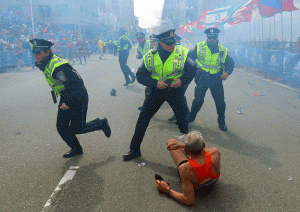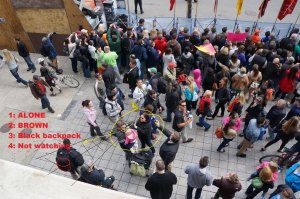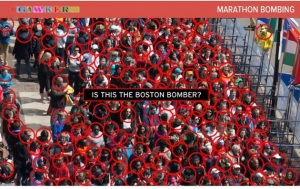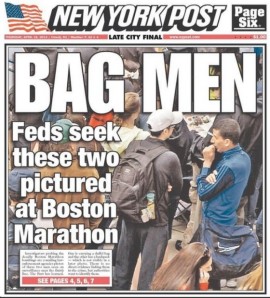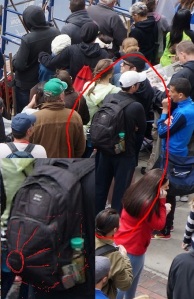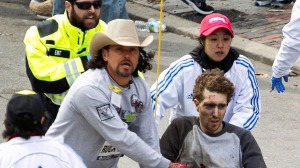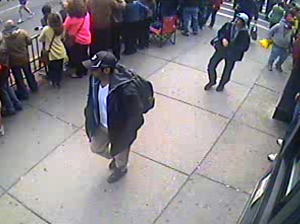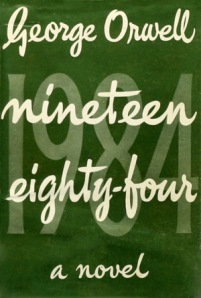Watch video of the Boston Marathon bombing. The uninjured can be seen continuing toward the finish line with a sense of trepidation–not yet terror. It was reminiscent of a decade ago–the moment when the first plane flew into the World Trade Center on 9/11–bystanders half confused and half in shock. A second explosion 10 seconds later would confirm their deepest fears: this was undoubtedly an attack on American soil. Following the bombings, law enforcement and citizens alike were left with more questions than answers. Specifically, who was the bomber? And, more importantly, where were they now?
On the day after the bombing, officials still had no potential suspects. In accordance, American citizens and self-prescribed ‘armchair detectives’ flocked to internet aggregators such as Reddit and 4Chan to contribute to an unorganized but thorough user-generated analysis of all available video evidence of the bombing. It became a terrorist version of “Where’s Waldo?”. Countless theories and accusations began to accumulate from the virus-like spread of information. Given the plethora of pictures and videos, coupled with the collective wisdom of an online community, it was plausible that the internet might find a suspect before the Feds. However, while online efforts proved to be tenacious, their analysis provided expectedly lackluster results: i.e. every brown-skinned man carrying a backpack suddenly became suspect.
A user-submitted image from 4Chan identifying the wrong suspect
Gawker summed up the shoddy investigating by poking fun at the ineptitude of internet sleuths:
In the end, the outpouring of information from the Internet transitioned from a serious investigation into a sociological study of racial profiling. Additionally, the fervent nature of the 24/7 news cycle was contributing to an uncanny amount of misinformation. At one point, CNN reported the bomber was captured and in police custody, only to later retract that statement entirely. The New York Post ran a front page photo in which they misidentified the same two suspects that the internet amateurs were outwardly suspicious of:
New York Post fail
Internet fail
The only information concerning the bomber which was available in the 24 hours following the attack was information based on assumptions. Al Qaeda and it’s affiliates hadn’t claimed responsibility for the attack (their crème de la crème), thus, we could assume it probably wasn’t a terror cell. Also, the bombs were placed at a specific location (at the finish line with the highest density of people), thus, we could assume the bomber knew the area, was familiar with the marathon, and was probably a Boston resident (at least for a short period of time). Finally, the bomb itself offered insight. It was a relatively cheap, do-it-yourself IED (improvised explosion device) (the same used by insurgents in Iraq and Afghanistan) (the same recipe featured in Al Qaeda’s online periodical [Inspire] using a pressure cooker as a bomb), thus, we could assume that they probably had ties to Islamic fundamentalism and were provided with limited outside funding (if any).
All of these assumptions were not far from the truth. The suspects were not Al Qaeda operatives. In contrast, they were two brothers from Chechnya. The younger brother was a naturalized citizen of the United States. He had attended high school in Boston and was an undergrad at UMass. The brothers lived together in Cambridge, just outside of the city. The suspects worked alone. They were both Muslim. Born in a region of the world that breeds fundamental Islam and Al Qaeda affiliates. Overall, they fit the description of a homegrown terrorist motivated by radical ideology.
Unlike failed domestic terror plots in the past (notably, the Nigerian “underwear bomber”, Umar Farouk Abdulmutallab, and the Pakistani-American “Times Square bomber”, Faisal Shahzad) the Boston Marathon bombing was executed with measurable results: mass casualties. Not to mention, the images were replayed in homes across America for an entire week–essentially the M.O. of terrorism. In terms of an attack of that nature, it was entirely successful. The bombers accounted for discretion, location, timing, and hysteria. What they didn’t account for was a witness: Jeff Bauman.
Jeff Bauman (bottom right)
Bauman was waiting at the finish line of the marathon for his girlfriend when the first bomb detonated at 2:49 p.m. Shrapnel from the blast destroyed Bauman’s lower legs. Unable to walk, he was wheeled to the nearest ambulance with the help of a good Samaritan who has become known colloquially as “the cowboy” (Carlos Arredondo, pictured above). He applied a makeshift tourniquet and pinched Bauman’s arteries closed with his bare hands. Arredondo was simply acting as any human would during a time of crisis. What he didn’t know–nor did anyone else at the time–was that keeping Bauman alive meant finding the bombers.
Bauman regained consciousness in a drug-induced haze following his double amputation procedure. Apparently, his first request was for a pen and paper. He managed to write eight words that would kickstart the most high-profile manhunt in recent history: “bag. saw the guy. looked right at me.” The Feds already knew–thanks to forensic evidence–that the bomb was placed in a backpack near the finish line. They already had multiple suspects who fit the description and location. All it took was Bauman to identify one man in a black hat and sunglasses: Tamerlan Tsarnaev. Within hours, the FBI had video surveillance of Tamerlan and his younger brother Dzhokhar, both carrying backpacks and moving through the crowd of spectators toward the finish line (See below). The Feds also claim they have unreleased footage of Tamerlan placing his backpack down and walking away, moments before it detonated.
And yet, we STILL don’t know who murdered Biggy and Tupac.
In 1949, a novel was published by author George Orwell, titled Nineteen Eighty Four. The setting is a dystopian future where citizens live under the rule of an omnipresent totalitarian government. In our world, the year 1984 is synonymous with Wall Street, synthesizers, and cocaine. However, in the novel, the conclusions made about the dangers of unchecked power are agreed upon by many to be an eerily accurate prophecy of contemporary society. This perception has become so ubiquitous among readers that the novel eventually spawned its own adjective to describe unjust government rule: Orwellian. The word is still commonly used today. More specifically, it is used to describe aggressive surveillance of a population by authority figures. Accordingly, in the aftermath of the Boston Marathon bombings, the term Orwellian effectively blurred the lines between fiction and reality.
On September 11th, 2001, no one was pointing a camera at the World Trade Center waiting for something to happen. In fact, I’m pretty sure cell phones were still kinda shitty and you couldn’t take video with them anyway. The point being, the Boston bombing was different in the sense that the entirety of the event was captured on video: the marathon, the suspects, the planting of the bomb, the explosions, the aftermath, and even the bombers reactions (unreleased footage apparently shows that both suspects remained at the scene to witness the chaos, which, consequently, helped apprehend them), the entire event was captured for the world to witness. It was put under the microscope. What remains is a visual timeline of a terrorist attack: a moment frozen in time.
Nineteen Eighty Four predicted that our future would be characterized by extensive surveillance. Cell-phone cameras and social media are both testaments to Orwell’s prophecy. More so, the Orwellian influence of the information age has paved the way for hypothetical “time travel”. Consider how the suspects were caught. Digital video provided a series of ones and zeros organized by time stamps. Collectively, they represented a re-playable moment in time. Given enough vantage points, one could theoretically recreate time itself. In doing so, it allows us to utilize the past like never before. All made possible by self-imposed “surveillance”.
Live coverage of the Boston bombing was so extensive, that the iconic Sports Illustrated image (below, right) was able to be captured by a different photographer, from a different location, at the exact same moment in time (below, left), all while the second bomb detonated in the background.
A single piece of video evidence–the Zapruder film–remains the reason why the JFK assassination continues to be the most discussed and debated conspiracy theory in American history. On November 22nd, 1963, Abraham Zapruder was standing in Dealy Plaza in Dallas, Texas, filming the president’s motorcade as it drove down Elm Street. He didn’t know it at the time but Zapruder’s 486 frames spanning 26 seconds would become the only video evidence of the assassination of JFK. It was subpoenaed during the Warren Commission as the only video evidence. Since becoming available to the public, the Zapruder film continues to fuel conspiracy theories to this day.
Zapruder was only one man with one camera. Consider how exponentially different it was on Boylston Street in Boston on April 15th, 2013. There were hundreds of Zapruder films, i.e. hundreds of perspectives in Boston that day. Within 24 hours of the bombing, the Feds had identified both suspects on surveillance cameras. Within another 24 hours they had both their names and faces plastered on the evening news. Within another 24 hours, they were found. At the end of five days, Tamerlan was killed in a shootout and Dzhokhar was captured alive. From start to finish, the Boston bombing narrative illustrated the inescapable nature of an Orwellian society.
In the coming weeks and months, what happened in Boston will be placed under the microscope. America will debate a handful of related issues: gun control, immigration reform, domestic terrorism, etc. The media will point fingers at who could have done what differently and the blame game will be played until the next tragedy strikes.
Expect to hear the phrase “Orwellian” tossed around the news as the media’s latest buzz word. It will spark a debate about whether or not our privacy has been diminished and personal freedoms infringed upon. The truth is, that’s already happening. Google managed to map every inch of the planet in a decade, imagine what the government is capable of. The one question we should be asking is: how extensive is surveillance of American citizens? Perhaps, Orwell’s prophecy is more fact than fiction.
UPDATE: NSA leaks info on top-secret PRISM program: the covert surveillance of American citizens through Facebook, Apple, Google, and more. (Guardian U.K.)
Well played, Orwell…

